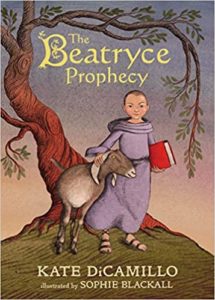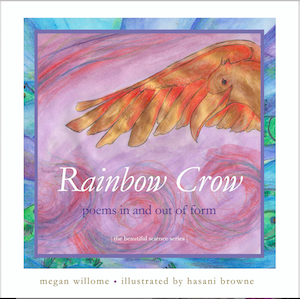The Beatryce Prophecy: Change the Story
Two-time Newbery-award winner Kate DiCamillo, has a new book, The Beatryce Prophecy. The cover illustration by Sophie Blackall shows a Medieval-looking girl whose head is shaved, with a book under one arm and a goat under the other.
The goat’s name is Answelica, and she has teeth “that were the mirror of her soul — large, sharp, and uncompromising.” With the help of Brother Edik, a boy named Jack Dory, a mysterious man with a beard named Cannoc, and, of course, with the goat, Beatryce transcends the Chronicles of Sorrowing that sought to determine her life’s path.
To do that, she has to change the story. It happens when she is summoned use her scribal skills to write the tale of a soldier:
“Beatryce bent again to the parchment. She crossed out the words I have killed.
She wrote, Once, there was a mermaid.”
There are so many ways to tell the truth. Memoir, the I have killed version, I find the least interesting. I much prefer the story version: Once, there was a mermaid. The first one may be true, but the second one is True.
Facts can be true without being True. Stories may or may not be true, but the good ones are always True. Any poem that lasts is True.
If Beatryce had written the soldier’s story as he told it, it might have been a bestseller. True crime podcasts would have picked it up. Censors would have banned it in school libraries. Instead, Beatryce, the child who will unseat a king, writes the story she wishes to read: Once, there was a mermaid. This version will be her story — hers and the story of the people she loves and who love her.
This kind of reframing is not only present in some of my favorite books, but also in many a poem.
In Martín Espada’s The Soldiers in the Garden, he tells the story of poet Pablo Neruda’s encounter with armed men who invaded his home. They could have killed him. Instead, Neruda changed the story. Espada writes,
Neruda faced him and said:
“There is only one danger for you here: poetry.”
What’s so dangerous about poetry? Good poetry lasts. It can rewrite history. It makes today beautiful, despite danger.
Kate DiCamillo has won the Newbery Medal twice, for Flora and Ulysses and The Tale of Desperaux, and she been a Newbery Honor-winner for my personal favorite, Because of Winn-Dixie. Two of her other books have been National Book Award finalists. She’s also authored picture books and early chapter books. The Tiger Rising was made into a movie earlier this year.
The Beatryce Prophecy is one of those chapter books that has occasional illustrations (something I quite enjoy). Sophie Blackall is an Australian author and illustrator who lives in New York. She has won the Caldecott Medal twice, for Finding Winnie: The True Story of the World’s Most Famous Bear and for Hello Lighthouse.
The story of Beatryce reminds us that there is more than one way to tell the story. Perhaps, in the physical act of writing, a new story emerges — the kind that can only come from the unexpected help of a bold goat.
Like this one, named Angel, who came to hear me read crow poems to Wee Fun Friday, sponsored by the Comfort Public Library one June morning when storms threatened but poetry changed the story.
Next Month’s Selection
Books have souls. A cat can save them. With the help of a hikikomori and a cup of tea. Join us for Children’s Book Club on Friday, September 9, as we read The Cat Who Saved Books by Sosuke Natsukawa.
Photo by Vinoth Chandar, Creative Commons, via Flickr. Post by Megan Willome.
Browse more Children’s Book Club
“Megan Willome has captured the essence of crow in this delightful children’s collection. Not only do the poems introduce the reader to the unusual habits and nature of this bird, but also different forms of poetry as well.”
—Michelle Ortega, poet and children’s speech pathologist
- Perspective: The Two, The Only: Calvin and Hobbes - December 16, 2022
- Children’s Book Club: A Very Haunted Christmas - December 9, 2022
- By Heart: ‘The night is darkening round me’ by Emily Brontë - December 2, 2022





Leave a Reply